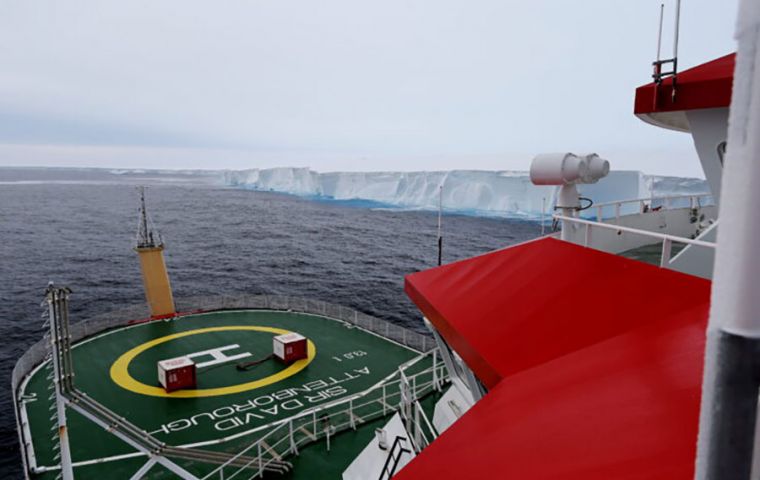MercoPress. South Atlantic News Agency
RRS Sir David Attenborough meets mega iceberg A23a drifting towards South Georgia
 New video footage shows the enormous iceberg, some 3,900km2 and 400m tall, twice the size of Greater London stretching out into the distance
New video footage shows the enormous iceberg, some 3,900km2 and 400m tall, twice the size of Greater London stretching out into the distance Scientists aboard the Falklands flagged RRS Sir David Attenborough collected samples of seawater around the A23a mega iceberg, the largest iceberg in the world. New video footage shows the enormous iceberg, some 3,900km2 and 400m tall, twice the size of Greater London stretching out into the distance beyond the research vessel.
Dr Andrew Meijers, Chief Scientist aboard the RRS Sir David Attenborough and Polar Oceans Science Leader at British Antarctic Survey (BAS), said: “It is incredibly lucky that the iceberg’s route out of the Weddell Sea sat directly across our planned path, and that we had the right team aboard to take advantage of this opportunity. We’re fortunate that navigating A23a hasn’t had an impact on the tight timings for our science mission, and it is amazing to see this huge berg in person – it stretches as far as the eye can see.”
A23a hit the headlines worldwide in the week of 24 November after it moved out of the Weddell Sea sector into the Southern Ocean. It calved from the Filchner Ice Shelf in 1986, before being grounded on the seabed nearby. A23a is now likely to be swept along by the Antarctic Circumpolar Current into ‘iceberg alley’, putting it on a common iceberg trajectory towards the sub-Antarctic island of South Georgia.
The RRS Sir David Attenborough passed the iceberg as part of its planned route towards the Weddell Sea, where the team will start the intensive 10/day BIOPOLE cruise. The cruise, which is the first scientific mission aboard the new research ship, is investigating how Antarctic ecosystems and sea ice drive global ocean cycles of carbon and nutrients. Their results will help us understand how climate change is affecting the Southern Ocean and the organisms that live there, from microscopic marine plants and tiny copepods to charismatic penguins and whales, and their roles in regulating our climate and keeping our oceans healthy and productive.
The #RRSSirDavidAttenborough has visited the largest iceberg in the world, #A23a
— British Antarctic Survey (@BAS_News) December 4, 2023
It's 3,900km2 - so a bit bigger than Cornwall.
The epic team on board, including Theresa Gossman, Matthew Gascoyne & Christopher Grey, got us this footage. pic.twitter.com/d1fOprVWZL
Laura Taylor, a biogeochemist working on the BIOPOLE cruise, explained the significance of the A23a samples: “We know that these giant icebergs can provide nutrients to the waters they pass through, creating thriving ecosystems in otherwise less productive areas. What we don’t know is what difference particular icebergs, their scale, and their origins can make to that process. “We took samples of ocean surface waters behind, immediately adjacent to, and ahead of the iceberg’s route. They should help us determine what life could form around A23a, and how this iceberg and others like it impact carbon in the ocean and its balance with the atmosphere.”
Professor Geraint Tarling, Principal Investigator on the BIOPOLE Program and Ecosystems Science Leader at BAS, says: “Calving of icebergs from Antarctica’s ice shelves is part of the natural life cycle of glaciers. Polar ecosystems play a crucial role in regulating the balance of carbon and nutrients in the world’s oceans and are impacted by melting icebergs in numerous ways. The data being collected will improve our understanding of these processes and their sensitivity to climate change.” (BAS)




Top Comments
Disclaimer & comment rulesCommenting for this story is now closed.
If you have a Facebook account, become a fan and comment on our Facebook Page!